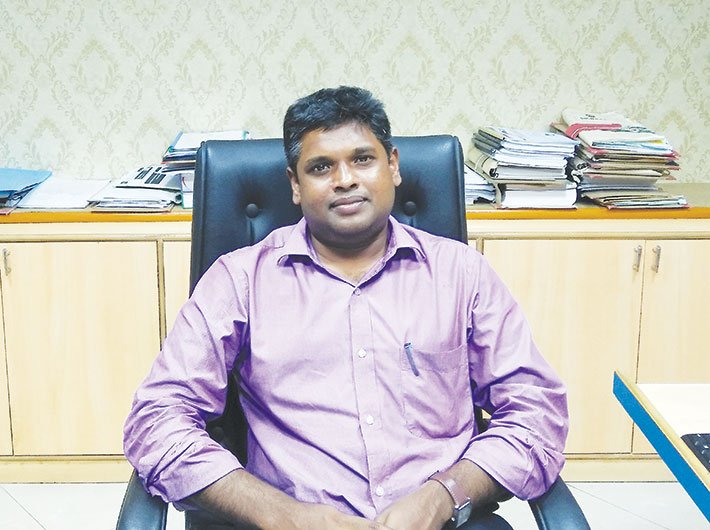Interview with V Arun Roy, MD, Chennai metropolitan water supply and sewerage board
For the past two years Chennai has been facing an acute water crisis. From desalination plants to recycling water, the city is doing everything to improve the situation. In an interview with Shivani Chaturvedi, Chennai water authority MD V Arun Roy explains the measures underway to tackle the perennial crisis.
What are the government’s plans to improve the water situation in Chennai?
Chennai never had adequate water. It has always been a water-stressed city. As early as in the 1940s, the mayor of Chennai had stated: “What kind of city we are in as it is a water starved city!”
The demand for water in Chennai is about 1,100 million litres per day (mld). At the best of times, we used to supply about 830 mld. Now with all our reservoirs running dry we are progressively going down and at present we supply about 470 mld. And this we are managing because of things like desalination plants. We have the highest installed capacity of desalination plants.
At present, Chennai Metro Water has two desalination plants in Minjur and Nemmeli with a capacity of 100 mld each. Out of 470 mld, about 40 percent of water comes from desalination plants. Then there are certain measures which only Chennai has tried such as hiring bore-wells from farmers in the nearby districts and carrying water to the city. About 100 million litres come from agricultural lands. The other thing that Chennai has tried is utilising abandoned mining quarries that have lots of water; this proved to be a great asset. Chennai is also getting water from Neyveli region and it has a good aquifer, plus there is Neyveli mines from where lot of water comes out, and is being pumped to Chennai.
The only permanent solution which the government is doing is water recycling. But before coming to recycling I would talk about water recharge, a method in which Chennai has been a pioneer. As early as 2001 we changed our building rules, making rain water harvesting structures compulsory in all buildings. Ever since, for any new building to get plan approval it has to have the rain water harvesting structure. And this is something which is more or less complied with because people are fairly aware that they need to have water for their own use. Recently, an independent NGO, Rain Centre, did a survey on rain water harvesting structures in Chennai and they found about 60 percent of the buildings are complying with it. However, how much water one can recharge depends on the rainfall the city gets. Last northeast monsoon was the worst in 140 years, so the city hardly received any rainfall.
Is there any solution for this acute water problem?
There are only two permanent solutions – one is water recycling, we have to get into recycling in a big way. Every compound should have its own recycling system where greywater and blackwater (sewage) is separate. Blackwater of course goes into the sewage system but today even greywater goes into the sewage system. Greywater should be recycled and used for gardening and flushing purpose. In fact, in 2001 our building rules said that with recharging there should be recycling systems also in all the special and multi-storeyed buildings. But the second part never really got enforced.
What is Chennai doing to get its water back?
From April 2017 we have made it compulsory for all ‘special buildings’ (ground floor plus two) and multi-storeyed buildings that have applied for water or sewage connection to have recycling mechanisms. Now none of these new buildings are getting connections unless they have recycling mechanism, whether they use it or not is a different issue. At least we are enforcing that they are given plumbing.
The other thing being done for recycling is that two tertiary treatment reverse osmosis (TTRO) plants with a combined capacity to treat 90 mld sewage are under construction. At present, we treat sewage water and pump it into water bodies like Cooum or Buckingham canal. That is called secondary treatment. Tertiary treatment goes through ultra-thin membrane, which purifies water further and then reverse osmosis is done. So it is actually potable water. This is what Singapore calls new water. They mix 30 percent of this new water with the old water. We are trying to produce 90 million litres of such water and supply it to industries. For both projects tenders are awarded and work has started on two locations – Koyambedu in west Chennai and Kodungaiyur in north Chennai. This water will be better than the water we are supplying in pipes as it is RO water. At present, we are looking it as an industrial supply project. For obvious reasons we don’t expect people to use it as drinking water, but if they are willing we will have to lay separate pipe for it, which is going to be too expensive. The cost of one project is Rs 394 crore and the other costs Rs 334 crore.
Another solution is to have more desalination plants. As of now Chennai is getting supply from 200 mld capacity desalination plants and the process of creating another 550 mld capacity is underway.
The fourth strategy is to restore our water bodies. Tamil Nadu has several irrigation tanks. As land got abandoned for urbanisation these tanks got encroached and they no longer serve the purpose. There is a need to reclaim these tanks and improve them and restore their supply channels. They act as additional storage structures.
To start with Chennai corporation and Tamil Nadu urban infrastructure and financial services limited (TNUIFSL) have prepared a detailed project report for 32 small tanks within and around the city. Some of these tanks are already encroached while the others are dead, in the sense that their flow channels are encroached or blocked. Plus, the Tamil Nadu water supply and drainage (TWAD) board prepared a Rs 400 crore project for rehabilitating tanks outside Chennai. Also, the state government has a scheme called sustainable water security mission.
At some places eviction of encroachment of water bodies may not be possible. However, restoration of the 32 identified tanks is not that problematic. Within cities there are tanks that are encroached. So we have to take a call if we want to evict the encroachment and carry out the water tanks rehab exercise or reclaim whatever is available. Some of these old water bodies have been occupied because the government itself had allowed layouts to be developed in those areas. Many such constructions have taken place under the government’s Eri (water bodies) scheme.
What are the challenges in the exercise of getting water back?
There are several. Things like recycling may not cost much, but we have to work with people so bringing behavioural change may be a challenge. Encroached water bodies and unplanned development of the city are other challenges. Funds are a huge constraint. Installation of desalination plants is an expensive process. TTRO again is expensive, as far as we are selling it to industries and they are buying it at a cost it is fine. But if we are going to domestic supply we cannot charge them like that. Also, availability of land is an issue.
Further, regulation is an issue. For example, coastal regulation zone (CRZ) norms are very strict. So to get clearance for a 150 mld desalination plant the process has been on for almost a year now. We are asked to submit various reports.
Many think that we wasted a lot of water during the 2015 floods by allowing it to flow into the sea. In a way it is correct. But at the same time we have to understand that we got a month’s rain in just two days. No reservoir could have stored that amount of water.
Majority of the sewage goes untreated into water bodies. How does Chennai aim to tackle this issue considering it is already facing a severe water crisis and water bodies are getting contaminated?
Sewage does goes into water bodies in multiple ways. It happens mostly because people rather than taking a sewage connection just connect it to the storm water drains, as many of the houses are unapproved. This way they don’t have to pay anything. Also, there are localities where population would have suddenly gone up and sewage lines are not strong, people make local arrangements and water is diverted to storm water drains. This is a solvable problem. We know these places and are taking corrective measures under various schemes. However, keeping pace with rapid urbanisation is not easy. And in Chennai the sewage problem is manageable as our treatment capacity is better.
shivani@governancenow.com
(The interview appears in the October 15, 2017 issue)

